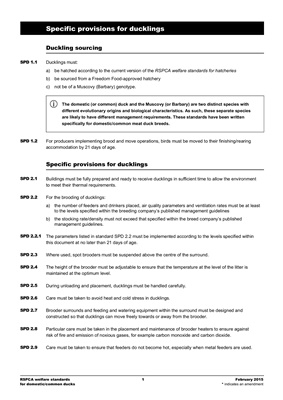
RSPCA welfare standards
for domestic/common ducks
1 February 2015
* indicates an amendment
Specific provisions for ducklings
Duckling sourcing
SPD 1.1 Ducklings must:
a) be hatched according to the current version of the RSPCA welfare standards for hatcheries
b) be sourced from a Freedom Food-approved hatchery
c) not be of a Muscovy (Barbary) genotype.
The domestic (or common) duck and the Muscovy (or Barbary) are two distinct species with
different evolutionary origins and biological characteristics. As such, these separate species
are likely to have different management requirements. These standards have been written
specifically for domestic/common meat duck breeds.
SPD 1.2 For producers implementing brood and move operations, birds must be moved to their finishing/rearing
accommodation by 21 days of age.
Specific provisions for ducklings
SPD 2.1 Buildings must be fully prepared and ready to receive ducklings in sufficient time to allow the environment
to meet their thermal requirements.
SPD 2.2 For the brooding of ducklings:
a) the number of feeders and drinkers placed, air quality parameters and ventilation rates must be at least
to the levels specified within the breeding company's published management guidelines
b) the stocking rate/density must not exceed that specified within the breed company's published
management guidelines.
SPD 2.2.1 The parameters listed in standard SPD 2.2 must be implemented according to the levels specified within
this document at no later than 21 days of age.
SPD 2.3 Where used, spot brooders must be suspended above the centre of the surround.
SPD 2.4 The height of the brooder must be adjustable to ensure that the temperature at the level of the litter is
maintained at the optimum level.
SPD 2.5 During unloading and placement, ducklings must be handled carefully.
SPD 2.6 Care must be taken to avoid heat and cold stress in ducklings.
SPD 2.7 Brooder surrounds and feeding and watering equipment within the surround must be designed and
constructed so that ducklings can move freely towards or away from the brooder.
SPD 2.8 Particular care must be taken in the placement and maintenance of brooder heaters to ensure against
risk of fire and emission of noxious gases, for example carbon monoxide and carbon dioxide.
SPD 2.9 Care must be taken to ensure that feeders do not become hot, especially when metal feeders are used.